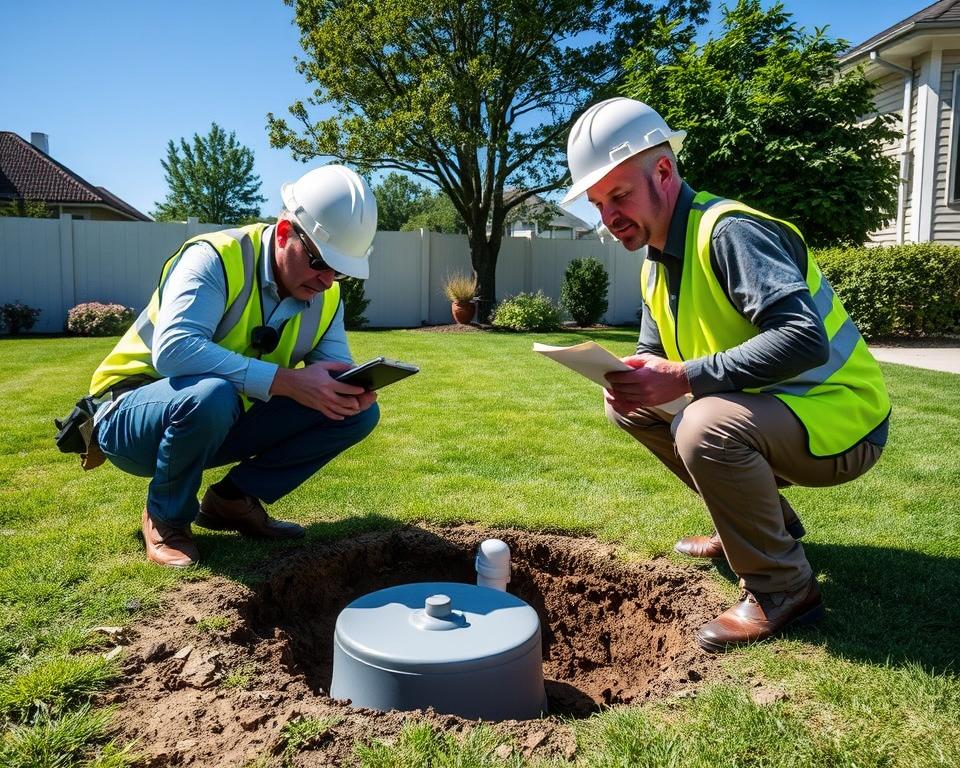Replacing a Septic Tank Pump: Your Guide
Ever wondered about the aftermath of a Septic Tank Pump breakdown? For many, it’s a scenario that creates serious worry and unforeseen costs. Realizing the need for timely replacement is essential in keeping a efficient and safe Septic system. By committing to periodic reviews, including rapid repair needs, you prolong your system’s life while skipping high emergencies. Companies like All in Sanitation serve a pivotal role in maintaining your Septic tank running properly. This guide seeks to give a comprehensive understanding of Septic Tank Pump replacement, exploring alert signals and care advice for emergency septic service.
Central Ideas
- Grasping the job of a Septic Tank Pump is crucial for homeowners.
- Prompt Septic Tank Pump replacement can reduce long-term expenses.
- Regular service and cleaning are critical to extending the lifespan of your Septic system.
- Skilled support can effectively manage Septic system Pump repair and maintenance.
- Catching initial symptoms of Pump failure can help prevent pricey restoration.
Knowing Your Septic System
A Septic system is essential for homes without access to municipal sewers. It handles and eliminates household wastewater securely. The Septic tank is key to this system’s performance, holding a pivotal position in the process.
The Septic tank accepts sewage, separating solids from lighter matter. This split is vital for effective wastewater treatment. The clarified water then flows to the drain field, where it gets further treatment by the soil, preserving groundwater.
Understanding how your Septic system operates can improve its life and efficiency. Consistent care is critical for the Septic tank and the system’s overall performance. Homeowners must understand their system’s details to avoid environmental damage and bypass costly repairs.
What is a Septic Tank?
A Septic tank is a underground, sealed container essential in household waste management systems. It’s essential to understand the Septic tank’s main function: it handles sewage waste storage by breaking it down. This setup operates by separating solids from liquids, supporting basic wastewater treatment and sanitation.
Its operation hinges on naturally occurring microorganisms that process waste. In locales without centralized sewage treatment, Septic tanks are irreplaceable. They retain sewage long enough for solids to descend, forming sludge. Meanwhile, liquid effluent collects above, preparing for filtration in the drainage field.
Maintaining a Septic tank in sound shape is critical for its reliability and durability. Routine care is important to preventing issues like backups and overflows. These situations can lead to costly fixes and pose environmental hazards. In essence, Septic tanks hold a key place in ensuring hygiene and safety, especially in rural areas.

Indicators You Need a New Pump
Homeowners should be alert of signs that their Septic tank may need a new Pump. A strong sign is experiencing foul odors at drains or in the yard, signaling a system failure. Facing regular or serious sewage backups in your home requires swift action to head off worse issues.
Noticing slow draining drains points to a potential problem. Fixtures like sinks, showers, or toilets that empty slowly might signal a Pump failure or a clog calling for an expert’s evaluation. Additionally, sections of excessively lush vegetation in your yard could mean trouble; this implies waste leakage, leading to overflow concerns.
To ward off large, pricey repairs, homeowners should deal with these signs immediately. Carrying out routine checks and maintenance is critical for the Septic system’s top function.
| Signs | Description |
|---|---|
| Foul Odors | Unpleasant smells around drains or yard pointing to system failure. |
| Sewage Backup | Recurring overflows in sinks or toilets signaling potential Pump issues. |
| Slow Draining Drains | Fixtures draining slowly can mean blockages or Pump malfunction. |
| Lush Vegetation | Areas of excess growth near the tank indicating possible overflow. |
When to Change Your Pump
Knowing the interval for replacing your Septic Pump is essential for a well-functioning Septic system. It’s smart to have your system assessed every three years. A skilled technician during these reviews delivers information into how well your system functions.
Usually, service of the Septic tank becomes necessary every five years. However, households with high demand or a big family might need shorter service intervals. Good maintenance of your Septic system avoids costly repairs and extends its lifespan. Professionals in Septic services can create a maintenance plan that fits your usage and the details of your system.
Remaining prepared with Septic Pump replacements maintains your system’s efficient operation and shields your home investment. Consistent checks and care prevent surprise expenses. They keep your Septic system working smoothly.
Replacement Cost Breakdown
The Septic Pump replacement cost changes, shaped by many variables. Homeowners should anticipate spending between $500 to $1,300 for a new Pump. This price range accounts for diversity in the model of Pump and material needs. It’s vital to include the Pump and Septic tank servicing costs for the placement and obligatory inspections.
Costs can also climb due to issues within the Septic system or local labor charges. Necessary repairs, prompted by wear or harm, could drive up the total outlay. In assessing financial estimates for Septic services, include charges for routine care, reviews, and any emergency calls since these factors are vital for maintaining your system’s longevity.
Planning financially for periodic Septic service reduces the impact of unforeseen costs. Early budgeting aids homeowners in covering expenses connected with the Pump’s replacement and system upkeep.
Pump Replacement Procedure
The Septic Tank Pump replacement commences with a thorough inspection of the system. This preliminary check identifies any additional issues besides the Pump itself. The worn-out Pump is then taken out cautiously and promptly.
Installing the new Pump entails exact care to leak-free joints, ensuring no leaks. Qualified technicians ensure the installation is accurately completed, lowering future issues.
The last step is a comprehensive finish inspection. It ensures effective operation, offering homeowners peace of mind. With professional assistance, the process is smooth, with little disturbance.
Best Practices for Installation
When performing Septic Pump installation, it’s important to follow best practices. Hiring experienced experts secures compliance with local regulations. They competently oversee the installation nuances, avoiding errors common in inexperienced setups.
Adhering to stringent Septic service standards is central for harmonious performance. Selecting appropriate components and quality materials extends the Pump’s life and optimizes the Septic system’s efficiency. This detailed care improves maintenance and overall performance longevity.
- Choose a reliable service provider who focuses in Septic systems.
- Verify that all necessary permits and inspections are in place before work commences.
- Use Pumps that match the specific requirements of your Septic system.
- Plan a pre-installation inspection to review site conditions.
- Keep in mind the layout and flow of the Septic system during installation.
Following these guidelines creates a hassle-free fit-out. It also provides a robust system for effective waste management.
Maintenance Advice
Avoiding costly problems with your Septic system begins with routine care. By following easy guidelines, homeowners can keep their Septic systems’ efficiency. Setting up consistent assessments is a smart move. It spots and rectify problems before they become serious.
It’s also vital to refrain from flushing harmful materials down the drain. Cooking oil, chemicals, and items that don’t break down can injure your system. Cutting water use during peak times can also ease system load.
Engaging pro cleaning with entities like All in Sanitation is vital for Septic health. Learning what you can and cannot do with your Septic tank can dramatically boost its lifespan and secure your household environment.
Understanding Cleaning Services
Routine Septic tank cleaning is vital for your system’s extended function and efficiency. The process entails extracting sludge, inspecting for damage, and making sure everything operates properly. These steps are critical to ensure continuous performance and ward off pricey problems.
A detailed Septic maintenance plan should consist of periodic assessments and cleanings that fit your specific demand. Homeowners must understand the importance of timely maintenance to avoid problems like backups. Using professionals guarantees the cleaning is detailed, supporting a hygienic home.
| Service Type | Frequency | Benefits |
|---|---|---|
| Pumping | Every 3-5 years | Prevents system failure and backups |
| Inspection | Annually | Identifies potential issues early |
| Maintenance | As needed | Increases the lifespan of the system |
Committing to regular Septic tank cleaning saves money and increases your system’s life. It maintains trouble-free waste handling. Moving promptly secures your Septic system’s efficiency for the future.
Picking a Pump Replacement Provider
Locating a trustworthy Septic service provider is crucial when replacing a Septic Tank Pump. Initially, ensuring their certifications and licenses. Such credentials validate the company’s compliance with industry norms, necessary for a seamless replacement process.
Reviewing customer reviews is also a key step. Past feedback reflects service quality, aiding in the filtering process. Select companies with a consistent track record of quality work and customer support.
Acknowledge recommendations from your community too. Insights from friends and neighbors can unveil top-notch Septic services in your vicinity. Always ask for detailed stories of their positive experiences with these services.
Finally, review the work scope and cost from various firms. A detailed analysis provides exceptional service and improves the value of your expenditure. Observing these guidelines secures your Septic system receives the top-notch care it requires.
Deciding Between DIY and Pros
Homeowners often wonder whether to tackle Septic issues personally or seek professional help. DIY Septic maintenance looks attractive for small fixes and upkeep. For example, monitoring Septic tank levels or clearing drainage lines can be done on your own.
On the other hand, recognizing when to hire Septic professionals is vital for serious problems. In-depth repair, replacing systems, or big blockages require specialized gear and know-how. Without the necessary skills, attempts to repair these problems can result in contamination and large-scale damage.
Figuring out between DIY and professional help involves assessing the job’s complexity. Presented below are examples showing when DIY is suitable and when professional Septic services are recommended:
| Situation | DIY Feasibility | Need for Professional Help |
|---|---|---|
| Routine maintenance (e.g., tank level checks) | Yes | No |
| Minor clogs in drain fields | Yes | No |
| Major Septic Tank Pump failure | No | Yes |
| Complex sewage backflow issues | No | Yes |
| Regular system inspections | Maybe DIY | Yes for thorough checks |
Acting knowledgeably on these matters secures safety and efficiency. Choosing correctly safeguards the Septic system but also avoids sudden charges.
The Bottom Line
Understanding the workings of your Septic system is vital for its proper care and your home’s smooth running. Spotting initial signals of issues prevents expensive repair costs and protects the system’s health. This preventive approach benefits the environment and raises your property value.
To keep your Septic system in prime condition, focus on maintenance. This entails routine checks and timely professional Pumping. This modest investment maintains your home’s safety and your household welfare. Your Septic system thrives with good care.
Our team at All in Sanitation is devoted to providing first-rate Septic care. We deliver the knowledge required to maintain your system performing at its best, securing your home investment over time. With our emphasis on reliable support and reliability, we’re ready to meet your Septic maintenance needs.

